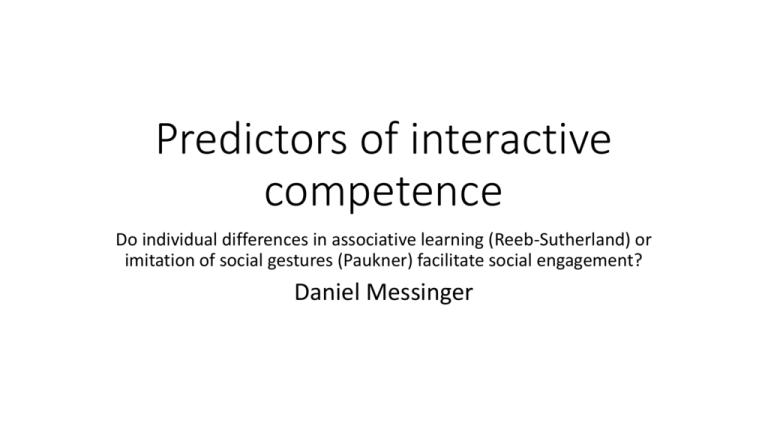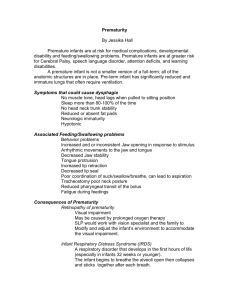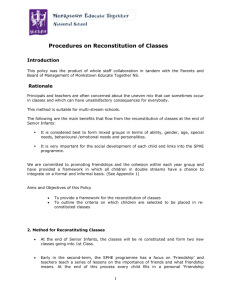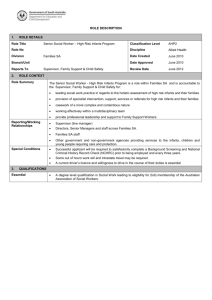Predictors of interactive competence
advertisement

Predictors of interactive competence Do individual differences in associative learning (Reeb-Sutherland) or imitation of social gestures (Paukner) facilitate social engagement? Daniel Messinger Overview • Examined whether individual differences in the rate of associative learning at 1 month of age predicts social, imitative, and discriminative behaviors across first year • H: Rate of associative learning would relate to individual differences in social behaviors • Faster learning at age 1 month associated with extent of expressed social behaviors across time points during first year Methods • 70 healthy infants • 1 Month Assessment • Delay eyeblink conditioning paradigm while asleep • UCS: airpuff • CS: tone • EMG data collected via electrodes on infant • Tone-airpuff paired trials, airpuff alone trials, and tone-trials • Each trial examined for eyeblink response defined as rapid deflection in EMG signal Learning curve for one-month-old infants Reeb-Sutherland BC, Levitt P, Fox NA (2012) The Predictive Nature of Individual Differences in Early Associative Learning and Emerging Social Behavior. PLoS ONE 7(1): e30511. doi:10.1371/journal.pone.0030511 http://127.0.0.1:8081/plosone/article?id=info:doi/10.1371/journal.pone.0030511 5 Month Assessment • Peek-A-Boo Task • Mom played peek-a-boo with infant • Puppet Task • Watches puppet show and is tickled by puppets 3 times • Assessed Social Responsivity • Coded social positivity – smiling intensity, intensity of vocalizations, and intensity of positive motor acts • Coded social referencing – looking at mother • Infant Behavior Questionnaire • Measured maternal report of infant temperament Results • Learning slope varied across infants • Some showed rapid learning; others showed little to no learning • Infants who learned more rapidly at 1 month showed more Social Responsivity at 5 months • Correlation still significant after controlling for maternal report of temperamental positivity 9 Month Assessment • Still-face task • 2 min normal interaction with mother • 2 minute mother looking at infant with neutral face with no interaction • 2 minute mother re-engages infant in normal interaction • Coded negativity (protest, withdrawn behaviors) • Social Contingency Detection – difference between proportion of negativity during still face phase and proportion of negativity during interaction phase • Modified peek-a-boo task • • • • Mom behind screen Trials 1, 2, 3, & 6: screen opens and mother says “peek-a-boo” Trials 4 & 5: screen opens and mother is gone Coded social positivity – smiling intensity, intensity of vocalizations, and intensity of positive motor acts • Social Contingency Detection – difference in social positivity between mother-present trials and mother-absent trials Results • 1 month Learning Slope positively correlated with Social Contingency Detection at 9 months • Infants who learn more rapidly have more changes in behavior following violations of social expectation 9 Month Assessment • Imitation Task • Presented infant with four novel toys • Experimenter demonstrated how to play with the toy (e.g., pushing button to ring bell) • Coded whether infant imitated target behaviors when given the toy Results • 1 month Learning Slope positively correlated with Imitation at 9 months • Infants who learn more rapidly at 1 month imitate more tasks at 9 months 9 Month Assessment • Mother-Stranger Face Discrimination Task • Assessed face-evoked neural activity • Infant shown 60 images of mother’s face and 60 images of a female stranger’s face while EEG data was recorded • Examined the Nc component, a fronto-central negative deflection that reflects aspects of visual attention • Larger amplitude when infants view mother’s face versus stranger’s face • Examined correlation between Learning Slope and differences in Nc amplitude between mother’s face and stranger’s face Results • Distribution of correlations between Learning Slope and Nc mean amplitude difference • Infants who learned more rapidly at 1 month showed greater discrimination in medial fronto-central activation to the mother’s versus a stranger’s face 12 Month Assessment • Early Social Communication Scale • Assessed joint attention • Experimenter presented attractive toys to infant • Infant’s behavior coded for responding to joint attention and initiating joint attention • Mullen Scales of Early Learning (MSEL) • Standardized test of general cognition • Assesses gross motor, fine motor, visual reception, receptive language, expressive language, and overall learning Results • No significant correlation between 1 month Learning Slope and MSEL overall learning composite (or any MSEL subscale) • 1 month Learning Slope positively correlated with Joint Attention at 12 months • Infants who learn more rapidly at 1 month show greater amounts of joint attention at 12 months Discussion • Why would infants who exhibit a steeper associative learning slope show greater social responsivity, social contingency detection, imitation, facial discrimination, and joint attention (but not overall learning as assessed by the MSEL)? • How might performance on a test of general cognition (MSEL) differ from associative learning (classical conditioning) in predicting the emergence of social behaviors? Background: Ferrari, P. F., Paukner, A., Ionica, C., & Suomi, S. J. (2009). Reciprocal Face-to-Face Communication between Rhesus Macaque Mothers and Their Newborn Infants. Current biology : CB, 19(20), 17681772. • • • • • • • • • • • Supplementary Material 01 Click here to view.(35K, doc) 02 Click here to view.(7.5M, mpg) 03 Click here to view.(16M, avi) 04 Click here to view.(7.2M, avi) 05 Click here to view.(6.7M, avi) Background: Early Social Interactions • Early social interactions provide a context for infants to learn social communication norms • Quality of face to face interactions in the first weeks of life can affect cognitive and social-emotional development • Eye contact is an important signal for social interaction and communication • Scanning of the eye area is a predictor of social & communicative abilities http://www.ncbi.nlm.nih.gov/pmc/articles/PMC2784245/bin/N IHMS145640-supplement-02.mpg FF in arms http://www.ncbi.nlm.nih.gov/pmc/articles/PMC2784245/bin/N IHMS145640-supplement-03.avi FF on ground Current Study • In macaque infants… – Lipsmacking plays a large role in communication between the mother and the infant – Tongue protrusion does not carry any communicative meaning – gaze is associated with affiliation • Test showed an avatar with a neutral still face followed by lipsmacking or tongue protrusion movements • Measured infant’s gaze towards the eye and mouth • Fixation of gaze • Duration of gaze Neonatal imitation (Days 1-7): Lipsmacking (LS) Neonatal imitation (Days 1-7): Tongue Protrusion (TP) Current Study: Research Aims • Question 1: Do infant macaques who imitate mouth movements in the first week of life show increased scanning of the eye region when 10-28 days old? • Question 2: Does the type of movement that infants imitate (lipsmacking or tongue protrusion) make them sensitive to the eye region when that movement is displayed? Results Lipsmacking nonimitators (n=21) Lipsmacking imitators (n=16) • Only lipsmacking imitation predicted a preference for the eyes during the Still Face condition • Infant macaques who imitated lipsmacking gestures at 1 week-old looked longer at the eyes than mouth of a still face at 10-28 days old • Lipsmacking imitators fixated more frequently on the eyes (relative to the mouth) than non-imitators during SF • Overall, infants looked less at the face during TP compated to SF & LPS • Socially relevant characteristics affect general interest in a display • More gazing at the eyes could be an indicator of the infant’s motivation to extract social information from others What does this mean for human infants? • If imitation leads to increases in an individual’s sensitivity to social cues… • Could have important implications for screening infants’ at risk for cognitive, social, and emotional difficulties • Could lead to earlier intervention







